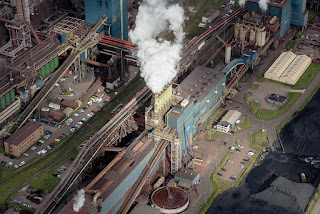Public opposition to sequestration will make it harder to reach the country’s carbon reduction goal.
As soon as the new Dutch government took office in October, it announced an aggressive target—to reduce carbon emissions by 49 percent by 2030. This will ultimately require the Netherlands to sequester 20 million metric tons of carbon dioxide per year—equivalent to the annual emissions produced by 4.5 coal-fired power plants.
Sequestering that much CO2 underground will be difficult, whether it’s captured directly from the flues of power stations and steel mills or extracted from the air. Currently, the Netherlands sequesters less than 10,000 metric tons of CO2 annually.
Gert Jan Kramer, a physicist at Utrecht University, says the government’s aims are “drastic” but possible. “The technology and the industrial capacity for storing underground tens of megatons [1 megaton = 1 million metric tons] of carbon dioxide is ready,” he says.
Underground natural gas reservoirs are already leakproof, and pumping CO2 into them while extracting gas would maintain their internal pressure, which would stabilize underground rock structure and prevent seismic activity. “We have investigated every event and consequence imaginable, and we’ve concluded that underground carbon storage is safe,” says Robert Hack, an engineering geologist at the University of Twente, in the Netherlands.
However, carbon sequestration projects have not fared well in Europe because of public opposition. More than 20 large-scale carbon capture and sequestration projects are now operational worldwide, but only two are based in Europe.
...
However, other scientists disagree with the idea that recycling CO2 to produce synthetic fuels can meaningfully reduce the amount of carbon in the atmosphere. One problem is that the same process that scrubs CO2 from the flue gases of a fossil-fuel power plant also reduces the plant’s electrical power output by up to 25 percent, says Hack. This is because that process requires a substantial amount of energy to heat, cool, and pump solvents that absorb CO2 from the flue gases.
Gunnar Luderer, a researcher at the Potsdam Institute for Climate Impact Research, in Germany, argues that synthetic fuel produced from CO2 for transportation is not really carbon neutral when captured from the flues of power plants. “You cannot have a second carbon capture from the emissions of a car or an airplane. In the end, it is fossil carbon that undergoes combustion twice,” he says.
Luderer agrees, however, that capturing carbon from the air and using it for purposes other than transportation changes the equation. Cement factories are known for their massive release of carbon into the atmosphere. Instead of capturing that carbon after the fact, it would make more sense to extract carbon from the air and use it to produce carbon fibers. These fibers are less corrosive than steel beams and require less concrete to cover. Using them in place of steel could reduce demand for concrete, and thereby cut emissions from its production. “Here, you would have a double benefit,” says Luderer.
Read more at The Netherlands Confronts a Carbon Dilemma: Sequester or Recycle?

No comments:
Post a Comment